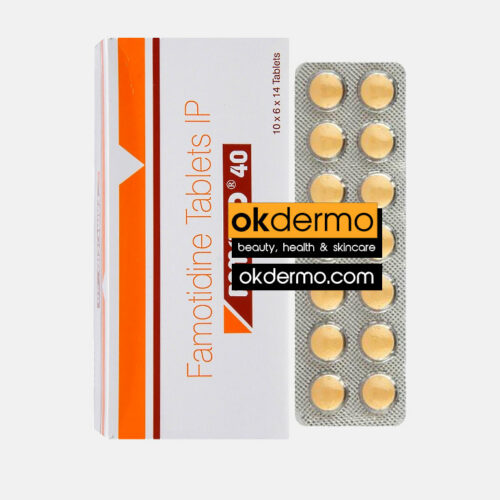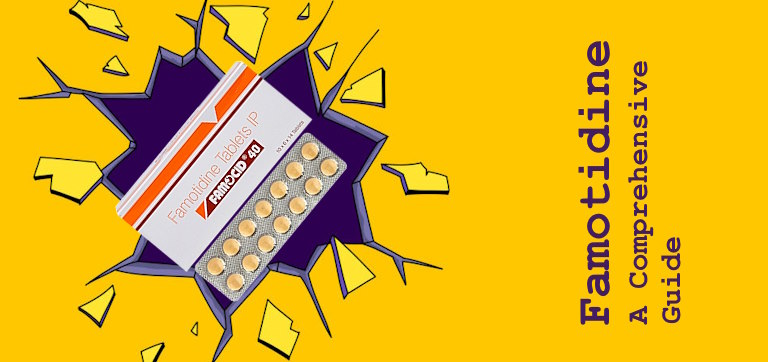Famotidine Tablet Uses & Considerations – A Comprehensive Guide
Table of Contents
Famotidine belongs to a class of drugs known as histamine H2-receptor antagonists, or more commonly, H2-blockers. Its primary function is to reduce the production of acid in the stomach.
Famotidine tablet uses extend to various conditions where there is excessive production of stomach acid, leading to a number of complications.
Understanding Famotidine
What is Famotidine?
Famotidine is primarily utilized in the treatment of gastric (stomach) and duodenal (small intestinal) ulcers and gastroesophageal reflux disease (GERD) – a condition characterized by the upward flow of stomach acid into the esophagus, leading to discomfort and potential damage to the esophageal lining – in both adults and children, effectively aiding in healing and preventing recurrence.
Additionally, it addresses other conditions related to the stomach and esophagus, including erosive esophagitis (esophageal irritation) and Zollinger-Ellison syndrome. The primary function of famotidine is to reduce the production of stomach acid, thereby alleviating associated symptoms such as persistent cough, stomach discomfort, heartburn, and difficulty in swallowing.
Moreover, famotidine is accessible over-the-counter (OTC), primarily for the treatment and prevention of heartburn due to gastroesophageal reflux in adults and pediatrics, highlighting its accessibility and widespread acceptance in managing these prevalent conditions.
Classification and Mechanism of Action
Famotidine is part of a group of medications known as histamine-2 receptor antagonists. It works by inhibiting the action of histamine on the parietal cells within the stomach lining. Histamine’s natural role is to stimulate these cells, prompting them to produce gastric acid. By blocking this stimulation, famotidine effectively reduces the secretion of acid into the stomach, providing relief and treatment for various acid-related disorders. Its influence extends to a duration of effect of at least 9 hours post-administration, ensuring lasting relief from acid-related discomfort.
Famotidine’s minimal effect on the cytochrome P450 enzyme system sets it apart from other medications in its class due to the reduced likelihood of drug interactions, making it a preferable choice.
-

Famocid® Famotidine Antacid Tablets
Famotidine 20mg / 40mg
Size: 98 Tablets
Brand name: Pepcid, Zantac, Act, Dyspep, Fluxid, Acid Controller, Heartburn Relief
From USD $14.00 Select options
Famotidine Tablet Uses and Dosage
Famotidine can be taken with or without food. If you are using the oral liquid form, use a proper measuring instrument like a marked spoon or cup, not a regular household teaspoon, to ensure accuracy.
Dosages vary based on the individual and the specific condition being treated. It is important to follow your healthcare provider’s guidance or the instructions on the label. The typical doses for various conditions are as follows:
-
- For ulcer prevention: 20 mg daily.
- For treating erosive esophagitis, GERD, or stomach ulcers: The dosage may range from 20 mg once or twice daily to 40 mg daily, depending on the patient’s weight and specific condition.
- For managing conditions like Zollinger-Ellison syndrome that produce too much stomach acid: The starting dose is often 20 mg every 6 hours, adjustable based on individual response.
- If you miss a dose, take it as soon as possible, but skip it if the next dose is almost due. Never double the dose.
Ensure you adhere strictly to the instructions provided by your healthcare provider or as indicated on the packaging when taking this medication. Deviating from the prescribed amount, frequency, or duration could increase the risk of side effects.
Even if symptoms improve, it’s crucial to continue using the medication for the entire duration recommended by your doctor.
Famotidine Uses for Dogs
Famotidine is used in treating and preventing various gastrointestinal conditions in dogs, cats, and other pets. Famotidine uses for dogs include:
-
- Ulcer Treatment and Prevention: Famotidine uses for dogs include healing and prevention of ulcers in the stomach and intestines, as well as erosions, which are minor damages to the stomach lining.
- Gastroesophageal Reflux Management: Gastroesophageal reflux or acid reflux, similar to heartburn in humans, involves the backflow of stomach acid into the esophagus. It’s particularly beneficial for dogs with megaesophagus, as it minimizes damage to the esophagus.
- Stomach Inflammation in Kidney Conditions: It’s beneficial in managing stomach inflammation linked to kidney ailments or renal failure.
- Mast Cell Tumor Treatment: For dogs with mast cell tumors, which can release substantial amounts of histamine, famotidine or similar drugs can be effective in treatment.
- Nausea and Appetite Issues: It’s often prescribed to pets experiencing nausea or a reduced appetite, enhancing their overall well-being.
- Allergic Reaction Management: As a histamine blocker, famotidine is sometimes used alongside other medications like steroids or diphenhydramine to manage allergic reactions.
Famotidine Side Effects
Although infrequent, famotidine can cause mild to severe side effects. It is important to be aware of famotidine uses and side effects that result.
Common Side effects – Usually mild and self-limiting:
-
- Adults: Headache, dizziness, constipation, diarrhea.
- Children: Restlessness, agitation, crying.
Serious Side effects – Needing immediate medical attention:
-
- Heart issues: Dizziness, fainting, shortness of breath, irregular rhythm.
- Muscle issues: Unexplained pain, weakness, fever.
- Neurological issues: Agitation, anxiety, depression, sleep problems, seizures, decreased sex drive.
- Liver issues: Weakness, loss of appetite, abdominal pain, dark urine, jaundice.
- Skin issues: Blisters, rash, mouth sores, or ulcers.
Understanding famotidine uses and side effects is essential for informed health decisions.
Special Considerations for Famotidine Tablet Uses
Famotidine Uses in Pregnancy
Famotidine uses in pregnancy are similar to its uses in general population. It is frequently used for heartburn and indigestion during pregnancy.
-
- Acid reflux is common in pregnancy due to increased progesterone levels and the growing uterus.
- Pregnancy hormones can slow digestive muscles, leading to a slower digestive process and issues like indigestion and heartburn.
- Hormones may also relax the valve between the esophagus and stomach, causing acid reflux and the associated burning sensation.
- If dietary changes do not alleviate heartburn, famotidine can be taken once or twice daily, with or without food.
However, always consult your doctor before starting any new medication during pregnancy.
Safety of Famotidine Uses in Pregnancy:
Research, including a 2014 American Family Physician journal study, indicates that H2 blockers like famotidine uses in pregnancy do not have teratogenic (abnormal fetal development) effects and are safe across all pregnancy trimesters.
Famotidine Intravenous (IV) Uses
Famotidine IV Uses
Famotidine, when provided as an intravenous (IV) solution, is reserved primarily for hospital use. It’s especially useful for patients who cannot take oral medication or those with severe conditions requiring immediate intervention. Common indications for famotidine IV uses include:
-
- Short-term management of active duodenal ulcers, with most patients improving within 4 weeks.
- Maintenance treatment for duodenal ulcer after initial healing.
- Addressing active benign gastric ulcers for up to 6 weeks.
- Managing symptoms of gastroesophageal reflux disease (GERD) and treating esophagitis caused by GERD.
- Treating conditions that cause excessive stomach acid production, like Zollinger-Ellison Syndrome.
Famotidine Other Uses – (Off-Label) Beyond Common Uses
Famotidine, primarily known for treating acid-related conditions, has potential beyond its common uses. Famotidine’s other uses in diverse areas are being explored by ongoing research.
Given its role in blocking histamine receptors, it is being studied for its potential in managing anaphylaxis. Recent studies also delve into its possible use in treating certain skin conditions like urticaria, where histamine plays a key role in symptom manifestation. Moreover, the COVID-19 pandemic has sparked interest in its potential role in viral symptom management, although these findings are preliminary and require further investigation.
Frequently Asked Questions (FAQs) about Famotidine
What happens after taking famotidine?
Famotidine acts by reducing stomach acid levels, offering relief from conditions such as heartburn and ulcers. The effect on acid reduction is quite rapid providing relief within an hour.
Is it safe to take famotidine every day?
Daily intake of famotidine is generally considered safe for treating certain conditions as prescribed by a healthcare professional. However, it’s crucial to follow the dosage and duration recommended by your doctor.
Is famotidine the same as omeprazole?
No, famotidine and omeprazole are not the same. Famotidine is a histamine-2 blocker, while omeprazole belongs to a class of drugs known as proton pump inhibitors. Both reduce stomach acid but through different mechanisms.
Why is it better to take famotidine at night?
Taking famotidine at night may be beneficial because it can control nighttime acid production more effectively. This can be particularly helpful for individuals experiencing nocturnal acid reflux or heartburn, ensuring a more comfortable and uninterrupted sleep.
References
- https://link.springer.com/article/10.2165/00003495-198632030-00001
- https://www.ncbi.nlm.nih.gov/books/NBK534778/
- https://jamanetwork.com/journals/jamainternalmedicine/article-abstract/615797
- https://link.springer.com/article/10.1007/BF01299910
- https://www.tandfonline.com/doi/abs/10.3109/00365528709090142
- https://link.springer.com/article/10.2165/00003088-199121030-00003
- https://avmajournals.avma.org/view/journals/ajvr/66/3/ajvr.2005.66.425.xml
- https://www.sciencedirect.com/science/article/abs/pii/S0149291896801779
- https://onlinelibrary.wiley.com/doi/full/10.1111/j.1365-2036.2005.02654.x
- https://www.aafp.org/pubs/afp/issues/2014/1015/p548.html
- https://www.sciencedirect.com/science/article/abs/pii/S1081120613008478
- https://academic.oup.com/ced/article-abstract/25/3/186/6628087
- https://www.frontiersin.org/articles/10.3389/fphar.2021.633680/full
Post by:
Marcella Jiovanni
Skin Care Professional
“Marcella Jiovanni actively promotes the importance of maintaining healthy skin, she envisions the future of dermatology as moving away from pure medical, pharmacological dermatology and flowing more toward a holistic approach to wellness and skincare.”

















